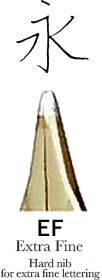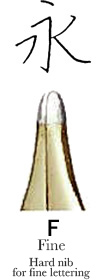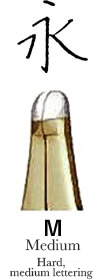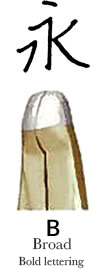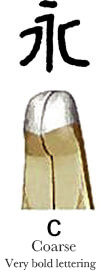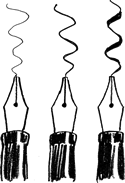Lending themselves well to writing Japanese,
Including the soft, smoothly written out lettering and the shades of the ink,
Including the soft, smoothly written out lettering and the shades of the ink,
there is a feel to fountain pen handwriting, and the personality and feelings of the writer become apparent.
The appeal of fountain pens lies in their ‘writing touch’, something that cannot be experienced with other writing instruments.
It is the nib that determines this writing experience.
Naturally delivering that writing feel, CUSTOM nib is entirely imbued with PILOT’s commitment to quality and awareness of the factors involved in writing Japanese.




Nib
Pen point
Nibs that possess an inherent
‘flex’ that exquisitely expresses
Tome (stops), Hane (upward brushstrokes or hooks), and Harai (sweeping strokes).
Expressing the subtle nuances present in written Japanese, such as Tome, Hane, and Harai, requires elasticity in the nib.
On account of its rust resistance and elastic properties, gold is used in CUSTOM Series nibs. To create the elasticity suitable for writing, we also use alloys (14- and 18-carat gold) that are mixtures of, for example, silver or copper and gold.
It is thus possible for us to create the ‘flex’ suited to the flourishes found in written Japanese.
14- and 18K gold defined
Gold is generally expressed on a scale of one to 24.
• Pure gold: 24/24 is 24K gold (1,000 parts per 1,000)
• 14K gold: 14/24, 14K (585 parts per 1,000)
The remaining 10/24 is a mixture of silver, copper, etc.
• 18K gold: 18/24, 18K (750 parts per 1,000)
One by one,
pen points with excellent wear resistance are polished by hand.
Abrasion resistant alloy is welded to the tip—termed the pen point—that comes into direct contact with the paper. This process makes the nib durable and resistant to wear even when used to write large amounts.
Also, the feel and performance of a fountain pen depend greatly on how the pen point is sharpened.
At PILOT, in the final process of nib production, each and every pen point is carefully sharpened by hand.
Taking into consideration the writing of Japanese, which has features, such as Tome and Hane, not found in the Roman alphabet, we have prepared 15 types of nib.
The characteristics of the metals made into these materials and the careful finishing by hand give rise to the nibs for CUSTOM fountain pens.
